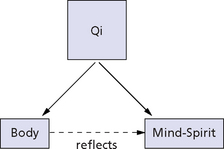Chapter 2 The Mind and Spirit are formed from the Prenatal Essences of the parents and are nourished by the Postnatal Essence of food and water taken in by the body. For example, Chapter 32 of the “Spiritual Axis” says: “The Mind and Spirit result from the transformation of the Essence of food and water.”1 Chapter 9 of the “Simple Questions” says: Heaven provides human beings with the five Qi [air] and Earth provides human beings with the five flavours [food]. The air is absorbed through the nose, and is stored in the Lungs and Heart. It ascends to make the complexion bright and lustrous and the voice sonorous. The food is taken through the mouth, and is stored in the Stomach and Intestines. After the food is digested and absorbed, the food Essence is delivered to the five Yin organs and therefore nourishes the Qi of the five Yin organs. When the Qi of the five Yin organs is in a state of harmony, the body can transform properly, body fluids are produced normally and the Mind and Spirit are formed.2 The Essence, Qi and Blood are the material foundation of the Mind and Spirit and, conversely, the Mind and Spirit are the external manifestation of Essence, Qi and Blood. Chapter 18 of the “Spiritual Axis” says: “The Stomach is in the Middle Burner, it opens into the Upper Burner, it receives Qi, excretes the dregs, evaporates the fluids, transforming them into a refined essence. This pours upwards towards the Lungs and is transformed into Blood … Blood is the foundation of the Mind and Spirit.”3 All the above quotations highlight the relation between the Essence, Qi, Blood and the Mind/Spirit. The “Great Dictionary of Chinese Medicine” says: “Human life originates from the Essence. It is maintained by Qi and manifested through the Mind and Spirit. Qi, Blood and Essence are the material foundation of the Mind and Spirit. Therefore, when Qi, Blood and Essence are sufficient, the Mind and Spirit are healthy. If there is deficiency of Qi, Blood and Essence, the Mind and Spirit suffer.”4 As we know, Qi is a subtle life force which is manifested simultaneously in the body in all its physiological activities and in the Mind and Spirit in its emotional and thinking activities (Fig. 2.1). For example, the pathological condition of Liver-Qi stagnation manifests with physical signs such as abdominal distension and simultaneously with emotional signs such as depression or mood swings. When observing and assessing the Spirit of a person, we should examine three separate aspects: The vitality of the Spirit is its manifestation in the general vitality of a person: the “energy” radiated by people which reflects their Spirit. Observation of the vitality of the Spirit is an integral part of the observation of the Spirit. If the vitality of the Spirit is vibrant, then a person will have a clear mind, high energy, a strong voice, regular breathing, clear thinking and quick reflexes. If the vitality of the Spirit is dull, a person will have low energy, a weak voice, dull expression, lethargy, apathy and, in severe cases, mental confusion. The chapter “Key to the Four Diagnostic Methods” of “The Golden Mirror of Medicine” says: “In the beginning of a disease, the state of the Spirit is important. The reason is that if the Spirit is strong at the beginning of a disease, it means that pathogenic factors cannot defeat the Upright Qi, as it is still strong. If the Spirit is dull, it shows that the Upright Qi cannot resist pathogenic factors as it is deficient.”5 No matter what the colour is, there should be lustre (shen). In lustre, one can differentiate light and body. “Light” refers to a bright appearance on the surface, while “body” refers to the moisture below the surface of the skin. Light has no form and reflects Yang and Qi. Body has a form and reflects Yin and Blood. If there is no abnormality of Qi and Blood, and Yin and Yang are in harmony, the lustre will have normal light and body.6
 OBSERVATION OF THE MIND, SPIRIT AND EMOTIONS
OBSERVATION OF THE MIND, SPIRIT AND EMOTIONS
INTRODUCTION
THE THREE ASPECTS OF THE SPIRIT
The vitality of the Spirit
Observation
Clinical significance
The lustre of the Spirit
Observation
![]()
Stay updated, free articles. Join our Telegram channel

Full access? Get Clinical Tree


OBSERVATION OF THE MIND, SPIRIT AND EMOTIONS

